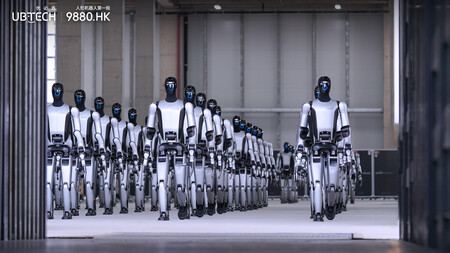In Fangchenggang, where control windows and cargo trucks outline the routine of a border with Vietnam, an experiment is being prepared that will not take place among laboratory prototypes, but among travelers, agents and logistics workers. China has chosen this place to test humanoids in real situations, with deliveries scheduled from December and very specific functions: guiding movements of people, supporting logistical tasks, participating in certain commercial services and carrying out inspections at both border posts and industrial facilities.
An ambitious contract. The agreement signed between UBTech and a center specialized in robotics in this border city amounts to 264 million yuan, about 34 million euros, and establishes the deployment of the Walker S2 model in different types of scenarios: border crossing, logistics areas and industrial complexes. According to the company, the humanoids will be intended to guide flows of people, organize internal transportation operations and carry out structured inspections in facilities linked to steel, copper and aluminum.
From prototypes to 800 million. UBTech arrived at Fangchenggang with a model that is no longer presented as a prototype, but as an industrial product. The Walker series has orders worth 800 million yuan by 2025, not including educational and research models. UBTech assures that it has already begun to deliver the first industrial batches of the Walker S2 and that its objective is to accelerate production at scale, with a view to manufacturing thousands of units and reducing costs so that humanoids enter real environments.
Robotic administrations. The rollout of UBTech fits into a broader trend within the Chinese public sector. The Zhejiang immigration office already uses robots for daily tasks, such as supporting people flows and information services. At Hangzhou Airport, one of these systems answers simple questions to passengers, while at the Shanghai Cooperation Organization summit in Tianjin, a multilingual robot developed by iBen Intelligence was used for protocol assistance.

The Fangchenggang initiative is part of a coordinated strategy from the State to organize the humanoid sector in China. The Ministry of Industry and Information Technology has created a specific national committee for this type of robots, chaired by the organization itself and made up of companies, innovation centers and relevant technical figures. It includes executives from UBTech, Unitree, AgiBot and representatives of the Shanghai innovation center. The goal is to set standards and accelerate the transition from laboratory to commercial and administrative applications.
What is relevant is not only that the humanoids have contracts and assigned functions, but also the place where they are going to test them. A border is a regulated space, with people in transit, goods, controls and tight times. If they work there, it will be easier to propose new applications in other public contexts. The Fangchenggang Pass serves as a laboratory, but also as a stage to observe what sharing tasks between machines and human workers entails.
Images | UBTECH
In WorldOfSoftware | NVIDIA is the most valuable company in the world because it had no competition. Until Google started making chips
